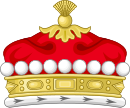
Viscount Newcomen, of Mosstown in the County of Longford, was a title in the Peerage of Ireland. It was created in 1803 (as Viscountess Newcomen) for Charlotte Gleadowe-Newcomen, Baroness Newcomen. [2] She had already been made Baroness Newcomen, of Mosstown in the County of Longford, in 1800, also in the Peerage of Ireland. [3] She was the wife of William Gleadowe-Newcomen, who represented County Longford in both the Irish and British House of Commons. In 1781 he was created a Baronet, of Carrickglass in the County of Longford, in the Baronetage of Ireland. [4] Lady Newcomen was the only child and heiress of Edward Newcomen, of Carrickglass, County Longford, grandson of Sir Robert Newcomen, 6th Baronet, of Kenagh (see Newcomen Baronets). At the extinction of the Newcomen baronetcy in 1789, the substantial family estates devolved on the future Lady Newcomen. Her husband was born William Gleadowe, but assumed at the time of their marriage the additional surname of Newcomen. [5] Sir William and Lady Newcomen were both succeeded by their son, the second Baronet and second Viscount. He sat as Member of Parliament for County Longford in the British House of Commons. The titles became extinct on his death in 1825.

